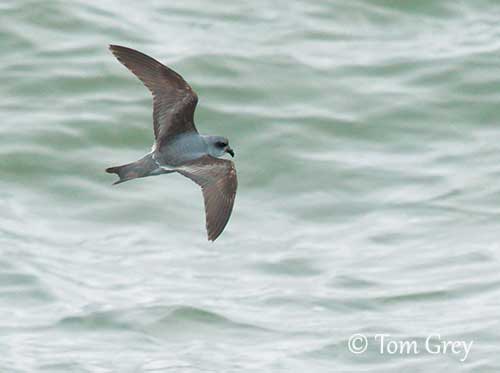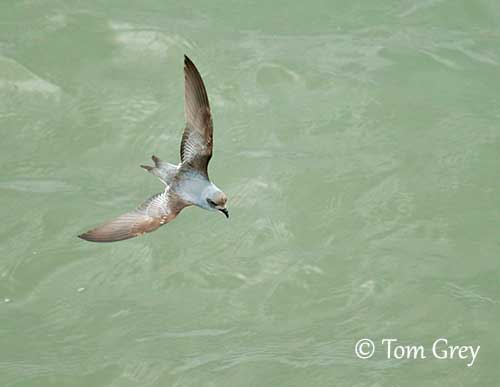
Fr: Océanite à queue fourchue
Ang: Fork-tailed Storm-Petrel
All: Gabelschwanz-Wellenläufer
Esp: Paíño Rabihorcado
Ita: Uccello delle tempeste forcuto
Nd: Parelgrijs Stormvogeltje
Sd: grå stormsvala
Photographer:
Tom Grey
Tom Grey's Bird Pictures & Tom Grey's Bird Pictures 2
Text by Nicole Bouglouan
Sources:
HANDBOOK OF THE BIRDS OF THE WORLD vol 1 by Josep del Hoyo-Andrew Elliot-Jordi Sargatal - Lynx Edicions - ISBN: 8487334105
OISEAUX DE MER – Guide d’identification de Peter Harrison – Editions Broquet (Canada) – ISBN-10 : 2890004090 – ISBN-13 : 978-2890004092
All About Birds (Cornell Lab of Ornithology)
The Birds of North America online
What Bird-The ultimate Bird Guide (Mitchell Waite)
Wikipedia, the free encyclopaedia
Bird Web (Seattle Audubon Society)
BREEDING BIOLOGY OF THE FORK-TAILED STORM-PETREL
Swallows of the Sea: the Fork-tailed Storm-Petrel - Fall 2007
BEHAVIOR AND ATTENDANCE PATTERNS OF THE FORK-TAILED STORM-PETREL
Alaska Seabird Information Series
Fork-tailed Storm-Petrel
Hydrobates furcata
Procellariiformes Order - Hydrobatidae Family
INTRODUCTION:
The Fork-tailed Storm-Petrel, also named “Swallow of the Sea”, is found in the North Pacific Ocean. It is highly pelagic and spends most of the year at sea.
They return to the breeding colonies in late spring, and typically nest in burrows or rock crevices. They feed on fish, crustaceans and squid, but they also follow the ships and can be seen with humpback whales. Outside of breeding season, they may remain near their breeding range until the edge of the pack ice in the Bering Sea.
Following eradication of introduced predators, the Fork-tailed Storm-Petrel has increasing populations on several islands. The species is not currently threatened.

DESCRIPTION OF THE BIRD:
Biometrics:
Length: 20-24 cm
Wingspan: 43-52 cm
Weight: 54-59 g
The Fork-tailed Storm-Petrel appears grey overall. Mantle and uppertail-coverts are mid grey to bluish grey, becoming darker slate grey on rear scapulars. On the grey upperwing, secondaries, outermost primaries and primary-coverts may appear darker. We can see the typical pale band across the upperwing coverts.
The tail is mid grey with darker tip. The outermost rectrices have whitish grey outer webs. The tail is forked, giving the bird its name.
The underparts are pale grey, but chin, upper throat and undertail-coverts are whitish. On the underwing, the flight-feathers are grey. The greater coverts are darker with pale tips whereas rest of coverts and axillaries are blackish with small whitish tips.
On the head, forehead and central forecrown are dark grey with blackish mask around the eyes. The rest of head is similar to the upperparts.
The slightly hooked bill is black. The eyes are dark brown. Legs and webbed feet are black.
Male and female are similar in plumage, but the female is slightly larger than male.
The juvenile resembles adults.
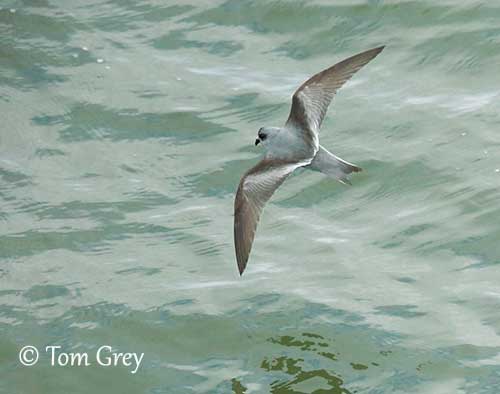
SUBSPECIES AND RANGE:
The Fork-tailed Storm-Petrel has two subspecies.
O.f. furcata is found in North Pacific. It breeds on N Kuril Islands, Commander Islands and Aleutian Islands. It winters from the edge of the pack ice in the Bering Sea to Hokkaido (Japan), rarely to Honshu.
This race is lighter and slightly larger.
O.f. plumbeus (displayed) is found in North Pacific too, but it breeds on W coast of North America, from Alaska S to N California. It remains near its breeding areas during winter.
This race is smaller (length: 20,5-22,5 cm). It is darker, dusky blue-grey overall.
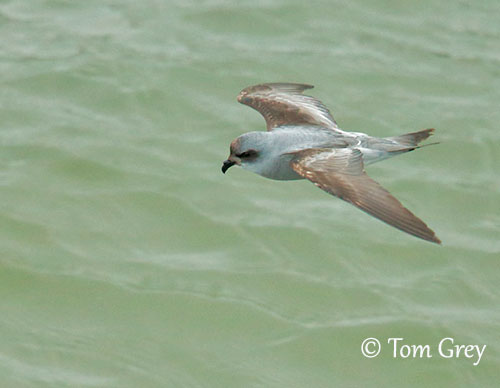
HABITAT:
The Fork-tailed Storm-Petrel is found in open ocean, in the cold waters of North Pacific Ocean. It forages over the continental shelf and also farther out to sea, but sometimes fairly close to the coasts.
It nests on islands, mainly in grassy areas, on rocky hillsides or among trees and shrubs, and even sometimes far from the sea.
CALLS AND SONGS: SOUNDS BY XENO-CANTO
The Fork-tailed Storm-Petrel is usually more vocal at breeding colonies where twittering and squeaking notes are given near the nesting burrows. The most common call is a raspy shrill “krreih kieh-kieh-kieh” uttered by both adults, in flight or on the ground and from inside the burrow. They are silent at sea.
BEHAVIOUR IN THE WILD:
The Fork-tailed Storm-Petrel feeds on fish, crustaceans, squid, carrion and floating refuse. It also feeds on oily fat from dead or wounded animals, taken by skimming over water surface with the bill.
It forages by hovering or flying low over the water, picking food at surface with the bill. It may drop into the water before to fly again or picks at prey while swimming. It also follows the ships.
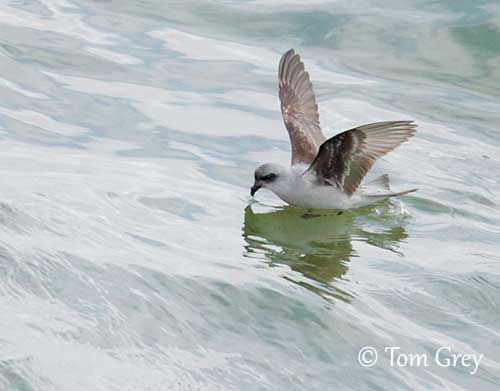
Both male and female are vocal during the breeding season. They call in flight and on the ground during courtship and aggressive interactions, and from inside the burrow.
The male gives a repeated call “krieh, krieh, krieh” also used to attract females. Mutual preening is part of courtship displays and usually, copulation follows this behaviour.
The Fork-tailed Storm-Petrel is a colonial nester and becomes active only at night in order to avoid predation. Both parents share the nesting duties.
The Fork-tailed Storm-Petrel disperses over adjacent waters after breeding, but it is not strongly migratory. They may occur in large numbers off C California during cold-water years.
It flies with rapid, shallow wingbeats interspersed with glides on stiff wings. It is able to fly in strong winter storms by zigzagging through wave troughs.
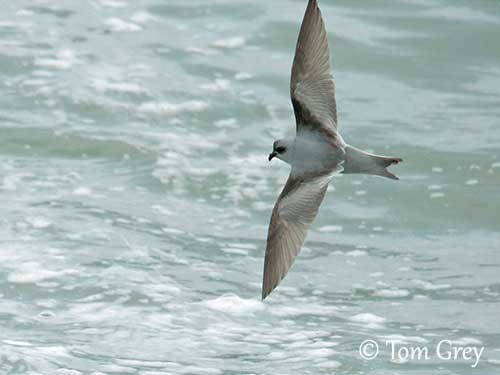
REPRODUCTION OF THIS SPECIES:
The breeding season usually starts in late April/June. The laying period extends over five weeks. The birds return to the colonies in late March, but earlier in California.
The Fork-tailed Storm-Petrel nests in colonies, often on offshore islands. They excavate the burrow in the soil, or nest in natural hollows such as rock crevices, or they use old burrows abandoned by puffins. Several pairs may nest in side tunnels sharing the same entrance. At the end of the burrow, the nest-chamber is sometimes lined (or not) with some grass.
The female lays a single, dull white egg with some fine dark markings. Both adults share the incubation during about 50 days, ranging from 37 to 68 days.
The chick is fed by regurgitation of orange oil substance, and later, of semi-digested fish. It fledges two months after hatching and goes out to sea.
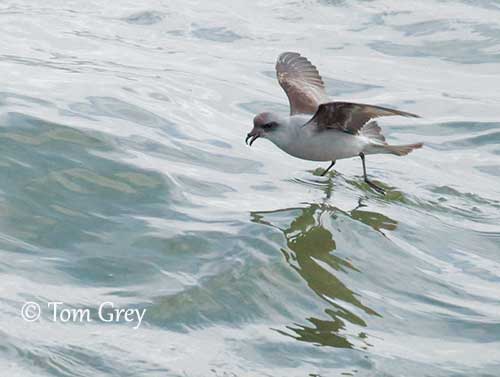
PROTECTION / THREATS / STATUS:
The Fork-tailed Storm-Petrel is vulnerable to natural predation by Peregrine Falcon and Western Screech-Owl during the nesting period.
However, eradication of introduced predators on several islands has led to the increase of the population, but this species is sensitive to human disturbances at colonies, especially near the nesting burrows.
They are threatened by ingestion of plastics and oil pollution when they follow ships. But both can be expelled when the bird regurgitates.
The global population was estimated to number more than 6,000,000 individuals in 2004. It is suspected to be increasing.
The Fork-tailed Storm-Petrel is not globally threatened and currently evaluated as Least Concern.
